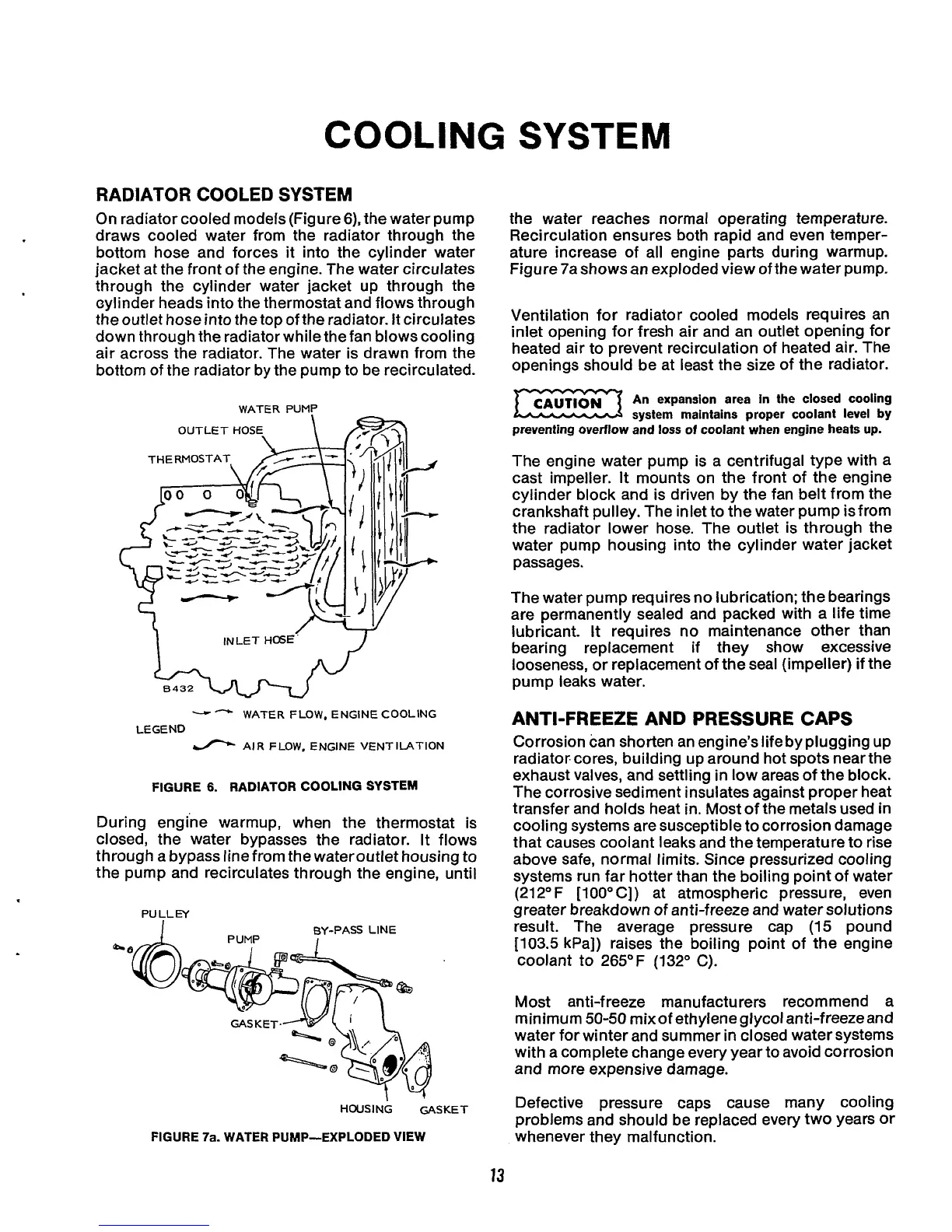COOLING
SYSTEM
RADIATOR
COOLED
SYSTEM
On radiator cooled models (Figure 6), the water pump
draws cooled water from the radiator through the
bottom hose and forces it into the cylinder water
jacket at the front of the engine. The water circulates
through the cylinder water jacket up through the
eylinder heads into the thermostat and flows through
the outlet hose into the top of the radiator. It circulates
down through the radiator while the fan blows cooling
air across the radiator. The water is drawn from the
bottom of the radiator by the pump to be recirculated.
WATER PUMP
--
WATER
FLOW,
ENGINE COOLING
c/"L
AIR
FLOW,
ENGINE VENTILATION
LEGEND
FIGURE
6.
RADIATOR
COOLING SYSTEM
During engine warmup, when the thermostat is
closed, the water bypasses the radiator.
It
flows
through a bypass line from the wateroutlet housing to
the pump and recirculates through the engine, until
PUGLEY
HOUSING GASKET
FIGURE 7a. WATER PUMP-EXPLODED VIEW
the water reaches normal operating temperature.
Recirculation ensures both rapid and even temper-
ature increase of all engine parts during warmup.
Figure 7a shows an exploded view of the water pump.
Ventilation for radiator cooled models requires an
inlet opening for fresh air and an outlet opening for
heated air to prevent recirculation of heated air. The
openings should be at least the size of the radiator.
An expansion area in the closed cooling
system maintains proper coolant level by
preventing overflow and
loss
of
coolant when engine heats
up.
The engine water pump is a centrifugal type with a
cast impeller.
It
mounts on the front of the engine
cylinder block and is driven by the fan belt from the
crankshaft pulley. The inlet to the water pump isfrom
the radiator lower hose. The outlet is through the
water pump housing into the cylinder water jacket
passages.
The water pump requires no lubrication; the bearings
are permanently sealed and packed with a life time
lubricant. It requires no maintenance other than
bearing replacement if they show excessive
looseness, or replacement of the seal (impeller) if the
pump leaks water.
ANTI-FREEZE AND PRESSURE CAPS
Corrosion can shorten an engine's
life
by plugging up
radiator. cores, building up around hot spots near the
exhaust valves, and settling in low areas of the block.
The corrosive sediment insulates against proper heat
transfer and holds heat in. Most of the metals used
in
cooling systems are susceptible to corrosion damage
that causes coolant leaks and the temperature to rise
above safe, normal limits. Since pressurized cooling
systems run far hotter than the boiling point of water
(212°F [lOO"C]) at atmospheric pressure, even
greater breakdown
of
anti-freeze and water solutions
result. The average pressure cap
(15
pound
[103.5 kPa]) raises the boiling point of the engine
coolant to 265OF (132"
C).
Most anti-freeze manufacturers recommend
a
minimum 50-50 mixof ethyleneglycol anti-freezeand
water for winter and summer in closed water systems
with a complete change every year to avoid corrosion
and more expensive damage.
Defective pressure caps cause many cooling
problems and should be replaced every two years
or
whenever they malfunction.
13
